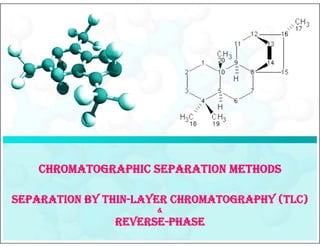
Sci 124 New Lab Chromatographic Separation Methods
- 1. CHROMATOGRAPHIC SEPARATION METHODS SEPARATION BY THIN-LAYER CHROMATOGRAPHY (TLC) & REVERSE-PHASE
- 2. CURCUMIN, ANYONE ? 1,529,560 New Cancer Cases in 2010 569,490 Cancer Deaths in 2010 Curcumin Prevents Cancer, Heart Disease, Alzheimer’s Disease and Obesity. Cancer Cell
- 3. PART 1: Thin Layer Chromatography Analysis of CURCUMIN in Turmeric Purpose: ISOLATION OF THE YELLOW PIGMENT CURCUMIN FOUND IN THE SPICE TUMERIC BY THIN-LAYER CHROMATOGRAPHY (TLC) METHOD & USING A POLAR ORGANIC SOLVENT. Curcumin Turmeric Root TUMERIC COMES FROM THE CURCUMA LONGA PLANT (GINGER-LIKE) FOUND IN ASIA. Cell Menbrane: Phospholipid Bilayer
- 4. PART 1: Thin Layer Chromatography Analysis of CURCUMIN in Turmeric Step #1: Heating Reflux 60 G OF STORE-BOUGHT TUMERIC SPICE MIXED WITH 150 ML DICHLOROMETHANE IN Water Out A FLASK Condenser REFLUX APPARATUS Water In Flask CONNECTION TO COLD WATER Sink Outlet Hot Water HEATED FOR 3 HOURS IN HOT Hot Plate WATER BATH (45°C)
- 5. PART 1: Thin Layer Chromatography Analysis of CURCUMIN in Turmeric Step #2: Suction Filtration Funnel VACUUM PUMP IS Rubber Stopper CONNECTED TO A FLASK Plastic Tubing WITH THE RIGHT SIZE TUBING PAPER FILTER IS PLACED INSIDE THE FUNNEL Flask Vacuum Pump FUNNEL IS SECURED INTO THE FLASK BY A RUBBER STOPPER
- 6. PART 1: Thin Layer Chromatography Analysis of CURCUMIN in Turmeric Step #3: TLC Analysis DROPPED 3 ML OF SOLVENT (5% METHANOL IN DICHLOROMETHANE) INTO BEAKER #1 SPOTTED A TLC PLATE WITH TURMERIC EXTRACT TLC PLATE IN BEAKER COVERED WITH WATCH GLASS Beaker #1 PREPARED 2ND BEAKER WITH SAME SOLVENT AS ABOVE BUT ADDED 3 DROPS OF METHANOL (INCREASE POLARITY) PREPARED PLATE #2 & REPEATED THE PLATES ARE TAKEN OUT AS SOON AS THE SOLVENT IS 1CM BELOW THE TOP OF THE PLATE Beaker #2
- 7. PART 1: Thin Layer Chromatography Analysis of CURCUMIN in Turmeric Step #3: Results of TLC Analysis CURCUMIN TRAVELED ON PLATE #2, SOLVENT FROM THE BOTTOM UP TRAVELED 8.10 CM ON PLATE #1, SOLVENT THE RF FOR 1ST SPOT TRAVELED 8.05 CM FROM BOTTOM UP IS 0.48 THE RF FOR 1ST SPOT THE RF FOR 2ND SPOT FROM BOTTOM UP IS 0.30 FROM BOTTOM UP IS 0.67 THE RF FOR 2ND SPOT THE RF FOR 3RD SPOT FROM BOTTOM UP IS 0.56 FROM BOTTOM UP IS 0.86 THE DARKEST SPOT THE DARKEST SPOT (2ND SPOT) IS CURCUMIN. (3RD SPOT) IS CURCUMIN. Rf= distance traveled by spot distance traveled by solvent TLC Plate #1 TLC Plate #2
- 8. EVER WONDERED WHAT IS IN YOUR GRAPE SODA? 2 SYNTHETIC DYES: Allura Red AC Brilliant Blue FCF Allura Red AC can be found in tattoo inks, cosmetics, children's medications, cotton candy. On June 30, 2010, the Center for Science in the Public Interest (CSPI) called for the FDA to ban Red 40. Brilliant Blue FCF is a synthetic dye made with aromatic hydrocarbons from petroleum. Can be found in ice cream, canned processed peas, dairy products, sweets, soaps, shampoos & mouthwash. It is poorly absorbed from the gastro‐intestinal tract and 95% of the ingested dye can be found in the feces.
- 9. PART 2: Separation and Analysis of Dyes in Grape Soda Purpose: ISOLATION OF THE TWO DYES FOUND IN GRAPE SODA USING A REVERSE-PHASE SEP-PAK C-18 CARTRIDGE. CH 3 Cell Menbrane CH 3 CH H C 3 3 Red Dye (FD&C #40), Allura Red Blue Dye (FD&C #1), Brilliant Blue
- 10. PART 2: Separation and Analysis of Dyes in Grape Soda Step #1: Separation of the Red Dye (FD&C #40) PRE-TREAT THE SEP-PAK CARTRIDGE WITH 10.0 ML OF 70% ISOPROPYL ALCOHOL SOLUTION 10.0 ML OF WATER. FORCE 5.0 ML OF GRAPE SODA THE SEP-PAK USING A SYRINGE. COLLECT THE 1ST FRACTION (ELUENT).
- 11. PART 3:Separation and Analysis of Dyes in Grape Soda FORCE 5.0 ML 5% ISOPROPYL ALCOHOL SOLUTION THROUGH THE SEP-PAK. COLLECT THE 2ND FRACTION REPEAT 3 X. THIS YIELDS FRACTIONS 3 THROUGH 5.
- 12. PART 3: Separation and Analysis of Dyes in Grape Soda FORCE 2.5 ML 5% ISOPROPYL ALCOHOL SOLUTION THROUGH THE SEP-PAK. COLLECT THE 6TH FRACTION REPEAT 4 X. THIS YIELDS FRACTIONS 7 THROUGH 10.
- 13. PART 3: Separation and Analysis of Dyes in Grape Soda Step #2: Separation of the Blue Dye (FD&C #1) FORCE 5.0 ML 20% ISOPROPYL ALCOHOL SOLUTION THROUGH THE SEP-PAK. COLLECT THE 11TH FRACTION REPEAT 3 X. THIS YIELDS FRACTIONS 12 THROUGH 14.
- 14. PART 3: Separation and Analysis of Dyes in Grape Soda SAMPLES’ OPTICAL DENSITIES ARE READ WITH A SPECTROPHOTOMETER. AMOUNT OF DYE IN ONE CAN OF GRAPE SODA: • 2.59 MG OF RED DYE • 0.36 MG OF BLUE DYE
- 15. SOURCES _____________________________________ http://en.wikipedia.org/wiki/Stearic_Acid http://qwickstep.com/search/sodium-chloride-in-water.html http://www.3dchem.com/molecules.asp?ID=176 http://www.btinternet.com/~martin.chaplin/molecule.html http://www.worldofmolecules.com/3D/turmeric_3d.htm http://upload.wikimedia.org/wikipedia/commons/6/67/Turmericroot.jpg http://en.wikipedia.org/wiki/Allura_Red_AC http://en.wikipedia.org/wiki/Brilliant_Blue_FCF http://en.wikipedia.org/wiki/Allura_Red_AC http://en.wikipedia.org/wiki/Brilliant_Blue_FCF http://www.northallegheny.org http://nih.gov/ http://drvikram.com/herbal‐products.htm http://www.madhealth.net/curcumin‐prevents‐cancer‐heart‐disease‐ alzheimer%E2%80%99s‐disease‐and‐obesity/ http://www.themoneytimes.com/files/cancer%20cells.jpg
- 16. THANK YOU TO PROFESSOR KIMBERLY STIEGLITZ _______________________ PRESENTED BY HELENE GAUDETTE FOR SCI 124 PRINCIPLES OF CHEMISTRY II